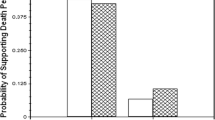Abstract
The current studies sought to test whether explicitly informing jurors of their power to nullify the law does invite “chaos,” defined by jurists as undisciplined and biased juror judgment. A series of four studies examined juror biases predicated on defendant status, remorse, gender, national origin, penalty severity, and extenuating circumstances. None, however, were amplified by nullification instructions, providing little evidence that such instructions invite chaos with respect to the biases examined in these studies. To the contrary, several results suggested that nullification instructions simply encourage jurors to nullify when the strict application of the law would result in an unjust verdict. Limitations of the studies and public policy issues are discussed.
Similar content being viewed by others
REFERENCES
Bodenhausen, G. V. (1988). Stereotypic biases in social decision making: Testing process models of stereotype use. Journal of Personality and Social Psychology, 55, 726-737.
Brown, D. K. (1997). Jury nullification within the rule of law. Minnesota Law Review, 81, 1149-1150.
Butler, P. (1995). Racially based jury nullification: Black power in the criminal justice system, Yale Law Journal, 105, 677, 723–725.
Butler, P. (1996, April). Tempering justice with racial mercy. Legal Times, pp. 19-20.
Cohen, J. (1988). Statistical power analysis for the behavioral sciences (2nd ed.). Hillsdale, NJ: Erlbaum.
Dane, F. C., & Wrightsman, L. S. (1982). Effects of defendants' and victims' characteristics on jurors' verdicts. In N. L. Kerr & R. M. Bray (Eds.), The psychology of the courtroom (pp. 83-111). New York: Academic.
Duane, J. J. (1996). Jury nullification: The top secret constitutional right. Litigation, 22, 6-60.
Federal Judicial Center (1987). Pattern Criminal Jury Instructions. Washington, DC: Author.
Horman, D. J., Campbell, J. D., & DeGregory, J. L. (1987). Gender and the attribution of the nurse practitioner and physician status. Medical Care, 9, 847-855.
Horowitz, I. A. (1985). The effect of jury nullification instructions on verdicts and jury functioning in criminal trials. Law and Human Behavior, 9, 25-36.
Horowitz, I. A. (1988). Jury nullification: The impact of judicial instructions, arguments, and challenges on jury decision making. Law and Human Behavior, 12, 439-454.
Kerr, N. L. (1978). Severity of prescribed penalty and mock jurors' verdicts. Journal of Personality and Social Psychology, 36, 1431-1442.
Kerr, N. L., MacCoun, R. J., & Kramer, G. P. (1996). Bias in judgment: Comparing individuals and groups. Psychological Review, 103, 687-719.
Miller v. Georgia, 260 Ga. 191, 196, 391 S.E.2d 642, 647 (Ga. 1990).
Myers, M. A. (1979). Rule departures and making the law: Juries and their verdicts. Law and Society Review, 13, 3-21.
Pfeifer, J. E., & Ogloff, J. R. P. (1991) Ambiguity and guilt determinations: A modern racism perspective. Journal of Applied Social Psychology, 21, 1713-1725.
Radzinowicz, L. (1948). A history of English criminal laws, Vol. 1. London: Stevens.
Rakove, J. N. (1996). Original meanings: Politics and ideas in the making of the Constitution. New York: Knopf.
Rindskopf, D. (1990). Non-standard log-linear models. Psychological Bulletin, 108, 150-162.
Robinson, D. T., Smith-Lovin, L., & Tsoudis, O. (1994). Heinous crime or unfortunate accident? The effects of remorse on responses to mock criminal confessions. Social Forces, 73, 175-190.
Rosen, J. (1997, February 24). One angry woman. New Yorker, pp. 48-59.
Rosenthal, R., & Rosnow, R. L. (1991). Essentials of behavior research: Methods and data analysis (2nd ed.). New York: McGraw-Hill.
Rovella, S. (1997, June 10). Convictions slowly rising: Criminal court juries are not increasingly nullifying. National Law Journal, p. A6.
Rumsey, M. G. (1976). Effects of defendant background and remorse on sentencing. Journal of Applied Social Psychology, 6, 64-68.
Savitsky J., & Sim, M. (1974). Trading emotions: Equity theory of reward and punishment. Journal of Communication, 24, 140-147.
Scheflin, A. (1972). Jury nullification: The right to say no. Southern California Law Review, 45, 168-189.
Scheflin, A. W., & Van Dyke, J. (1991). Merciful juries: The resilience of jury nullification. Washington and Lee Law Review, 48, 165-183.
Simson G. (1976). Jury nullification in the American system. Texas Law Review, 54, 488-504.
Tabachnick, B. G., & Fidell, L. (1996). Using multivariate statistics (3rd ed.) New York: Harper & Row.
United States Sentencing Commission. (1994). Guidelines manual (with amendments through November 1 1993). St. Paul, MN: West.
United States v. Dougherty, 475 F. 2d 1113, 1130–1137 (D.C. Cir. 1972).
United States v. Sepulveda, 15 F. 3d 1161, 1190 (1st Cir. 1993).
United States v. Thomas, 116 F. 3rd 606 (2d Cir. 1997).
Van Dyke, J. (1970). The jury as a political institution. Catholic Law Review, 16, 224-270.
Vidmar, N. (1996). Medical malpractice and the American jury. Ann Arbor, MI: University of Michigan Press.
Vidmar, N. (1998). The performance of the American civil jury: An empirical analysis. Paper presented at University of Arizona College of Law, Tucson, Arizona, April 17–18, 1998.
von Eye, A., & Niedermeier, K. E. (in press). Statistical analysis of longitudinal categorical data in the social and behavioral sciences. Hillsdale, NJ: Erlbaum.
Wiener, R. L., Habert, K., Shkodriani, G., & Staebler, C. (1991). The social psychology of jury nullification: Predicting when jurors disobey the law. Journal of Applied Social Psychology, 21, 1379-1401.
Weiler, P. C. (1991). Medical malpractice on trial. Harvard University Press, Cambridge, MA.
Weinstein, J. (1998). The many dimensions of jury nullification. Judicature 81, 168-171.
Author information
Authors and Affiliations
About this article
Cite this article
Niedermeier, K.E., Horowitz, I.A. & Kerr, N.L. Informing Jurors of Their Nullification Power: A Route to a Just Verdict or Judicial Chaos?. Law Hum Behav 23, 331–351 (1999). https://doi.org/10.1023/A:1022360632283
Issue Date:
DOI: https://doi.org/10.1023/A:1022360632283




